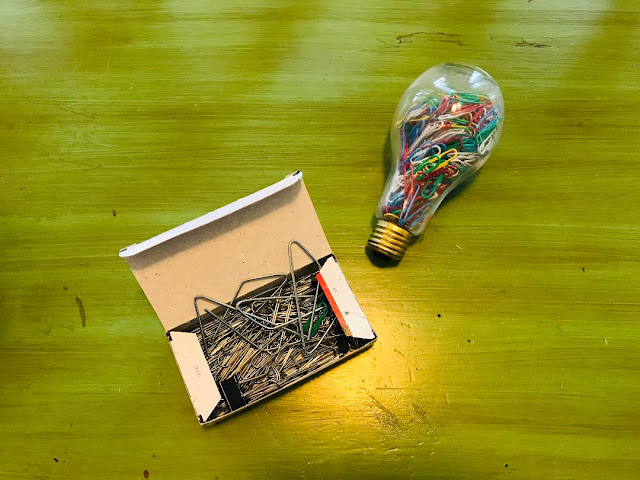 |
| How many uses can you think of for a paperclip? What if that paperclip were 50 feet long and made of foam rubber? |
Divergent Thinking
Divergent thinking is a skill related to creativity, and whether folks realize it or not, they often use this skill; or they “use it or lose it,” as the case may be. One very famous study, for example, asked that kindergarten students think divergently about uses for a paperclip.
The findings of that study?
Our capacity for divergent
thinking deteriorates with age. A longitudinal study of kindergarten children
measured 98% of them at genius level in divergent thinking. Five years later,
when they were aged 8 to 10 years, those at genius level had dropped to 50%.
(Abbasi)
People use divergent thinking when they think up “novel
ideas,” sometimes based on ideas that already exist (“Divergent Thinking”). A
cook might change up an old recipe, for example, or a fashionista might incorporate
a new item into a current wardrobe. A student might fix his glasses with a
paperclip if they break during class. There are many ways to exercise creativity
and an ability to think divergently.
The Bucket List
An exercise similar to the paperclip experiment is listed in
Ed Bell’s book, The 30-Day Creativity
Challenge. In an exercise he calls “The Bucket List,” he asks readers to
take ten minutes to list all the uses they can imagine for a bucket (2). Even
better, he reiterates the definition and importance of divergent thinking: “Creativity
is about taking existing concepts and ideas and doing something new with them”
(2).
Playing "What If?"
One commonality between the paperclip experiment and Bell’s “The
Bucket List” exercise is that the practitioner asks the student or reader to
work alone. However, what if after
the lists are created as a solo activity, people then work together to share
experiences and expand their understanding of the problem? In this version of
brainstorming, the groups or teams might discuss how they envisioned the bucket
as they created their original lists, what it was made of, how big it was, how
much water it held, or its condition. It’s very likely that each person’s imagined
bucket is slightly different: Some might be plastic beach buckets, and some
might be feed buckets, and others might be galvanized garden buckets, while
others still might be wooden pails.
To expand the experience even further, the groups or teams can
be asked to think of new “What if” scenarios for their buckets and generate more ideas for uses of those buckets:
·
What if the bucket was cut in half? Cut in half
the other way?
·
What if the bucket held 1000 gallons of water?
·
What if the bucket was made of bread?
·
What if there was a hole in the bucket? How big
is the hole?
The “What If” exercise can be an excellent starting point
for discussion about the abstract nature of language (as students realize their
idea of bucket is based on their own experiences, not inherently linked to the
word “bucket”). The exercise can also be used to demonstrate the power of
brainstorming within groups, or be used to point out the different types of
energy required to work either alone or together. Furthermore, it’s an
effective way to practice divergent thinking, and if people don’t use that
skill, they will lose it.
Works Cited
Abbasi, Kamran. “A Riot of Divergent Thinking.” Journal of the Royal Society of Medicine,
vol. 104, no. 10, Oct. 2011, pp. 391–391, doi:10.1258/jrsm.2011.11k038.
Bell, Ed. The 30-Day
Creativity Challenge. The Song Foundry, Inc., 2019.
"Divergent thinking." Palgrave Key Concepts:
Key Concepts in Innovation, Hamsa Thota, and Zunaira Munir, Macmillan
Publishers Ltd, 1st edition, 2011. Credo Reference. Accessed 09 Jan. 2020.
Want to read more? Try
Copyright Amy Lynn Hess. Please contact the author for permission to republish.
.JPG)


What a great introduction to a great idea. Thank you for this.
ReplyDeleteYou're very welcome! : )
DeleteHmmmm. The bucket that popped into my mind was a thick wooden bucket that probably held 2 gallons and had a thick wire bail. Why that was my first impression of a bucket would be fun to figure out.
ReplyDeleteThat WOULD be fun to figure out! New exercise!!
Delete